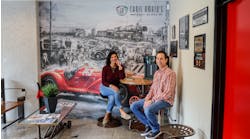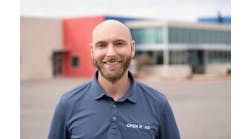Seattle, 1984: three young men, two of them students at the University of Washington, were tasked with repairing a professor’s Honda in a campus parking lot. It proved to be their entrance exam into professional automotive repair.
“The joke at the time was that we had earned the ‘Doctor of Honda’ degree,” explains Fred Wilson. The only one of the trio who would actually earn a degree, Wilson, with his twin brother Tom and their friend Randy, took this as a sign — literally — naming their new shop Dr. Honda later that year.
|
At a Glance: High Road Automotive |
|
Seattle, Washington Location |
|
Fred and Kathy Wilson Owners |
|
1 No. of shops |
|
35 Years in business |
|
8 No. of employees |
|
6,500 Square footage of shop |
|
13 No. of bays |
|
55 No. of vehicles per week |
|
$1.6 million Annual gross revenue |
“What we did for marketing was run around on bicycles and put little half sheet flyers on Honda windshields,” Wilson recalls. “There were thousands of them in the neighborhood, because this was back in the day when they all came from Japan, and they came off the boat about a mile and half from the shop. The market was just flooded with them.”
With Seattle being a port of entry for Asian imports, domestic makes had pretty much disappeared from the area by the 1980s. By the 90s the shop would expand into other lines, thus changing the shop’s name to its current High Road Automotive, but still all-Asian.
“We just started taking in Toyotas and Subarus and learned about them the hard way — whether that was smart or not,” Wilson laughs. “They’re not that much different so it wasn’t that hard, but occasionally we’d find we needed a special tool for this or that.”
What they learned from these experiences was written down in what would become the shop’s policy manual. Wilson’s partners would eventually move on to other endeavors, but he carried on compiling knowledge. The shop now runs on carefully curated checklists and procedures. For example, most day-to-day tasks are now in their custom computer program.
“You cannot sign off that you’re done with something until you’ve signed off the checklist,” he explains. “It’s basically a training device that’s written into our software. Say you’re doing a wheel bearing; the checklist is going to ask did you torque wheel lugs, are the ABS sensors properly installed — it’s that level of detail, and each job has its own particulars. It’s on software that we wrote and I’ve never seen anything like it anywhere else.
“It’s not fly-by-your-pants anywhere,” Wilson states. “If I see a tech doing things that aren’t by the book, I may correct him right then, but I’m going to be nice and sweet about it, because I figure it’s my fault; it’s either in the book and I haven’t trained it properly, or that setup wasn’t covered in the book. One way or the other, I just jot down a note and we go change the book. Then we go back and change the technician.”
High Road pairs younger techs with older ones as much as possible. “It’s essentially an apprentice program,” explains Wilson. “We pull in 20-somethings and set them next to a guy who’s been here 10 years. They learn inspection first because our inspection stuff is crazily extensive; through that they learn the car’s problems. Then they move on to oil changes, fluids — that way we work them organically up, and it can take two or three years.”
Wilson goes on to explain that High Road’s inspection and maintenance program is comprised of roughly three levels, although there are an infinite number of options between them. But any configuration would probably please a customer, since they’re marketed on the shop’s website as a ‘car day at the spa.’
“The simplest is where we’re only going to look at straight safety," he notes, “Are brakes falling off, tires bald, ball joints worn out? At the medium level we’ll look at those safety items plus a year, pointing out those things that are kind of worn. Then the ‘white glove;’ a full bumper-to-bumper, nitty-gritty inspection, noting things like are the foot pedals wore out. We don’t have that many customers who want that level, but they’re out there. You get a list and you pick what you want.
“We have always been teamed-based on our tech crew,” Wilson points out. “One guy will work on a car and if it’s getting behind, we’ll put another technician on it because they’re paid hourly. We’ve never done flat rate so there’s no grand incentive.” Under this system technicians also don’t specialize in any one brand.
“I’m a student of people and psychology,” he muses. “I’m actually more interested in that than management techniques; I change how I manage based on that.” Having done some management training — with plans to do more — he’s keenly aware that technicians should distance themselves from their former job to become owner/managers. However, Wilson doesn’t feel he can.
“I am the technical expert,” he emphasizes. “There’s nobody else here with a degree in mechanical engineering; they’re all going to come to me. What I did do on the profit side is I don’t talk to customers about money, ever, if I can help it. I’ve got two and half service advisors to do that.”
For technical expertise has become something of a language barrier for Wilson. As the shop’s Ballard location transitioned from being a fishing village on Puget Sound to part of the Northwest’s burgeoning tech industry corridor, newer residents were noticeably less knowledgeable on cars. Bottom line? “My customers are machinery-challenged,” laughs Wilson.
On the other hand, “everything in marketing here, even word of mouth, is electronic,” he explains. “The most important thing to maintain here is your Yelp! rating. You also have to have an excellent website or they’ll laugh you off the face of the earth. It’s weird, because you’re in this place where everybody is connected to everybody, they can quickly find out your online reputation. They live on their phones; everything we send the clients has to be adaptable to be seen on a phone. That’s how high-tech this place is.”
The days of dropping flyers on windshields are long gone.


